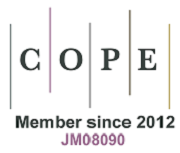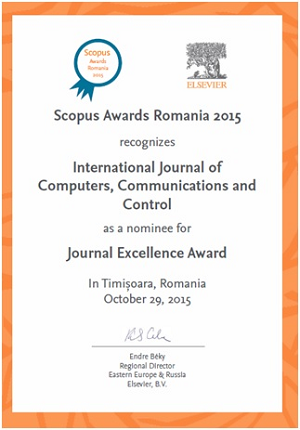Robust Adaptive Neural-Fuzzy Network Tracking Control for Robot Manipulator
Keywords:
Adaptive control, Neural-fuzzy network, robot manipulatorAbstract
This paper presents a robust adaptive neural-fuzzy network control (RANFNC) system for an n-link robot manipulator to achieve the highprecision position tracking. Initially, the model dynamic of an n-link robot manipulator is introduced. However, it is difficult to design a conformable model-based control scheme, for instance, external disturbances, friction forces and parameter variations. In order to deal with this problem, the RANFNC system is investigated to the joint position control of an n-link robot manipulator. In this control scheme, a four-layer neural-fuzzy-network (NFN) is used for the main role, and the adaptive tuning laws of network parameters are derived in the sense of a projection algorithm and the Lyapunov stability theorem to ensure network convergence as well as stable control performance. The merits of this model-free control scheme are that not only the stable position tracking performance can be guaranteed but also unknown system information and auxiliary control design are required in the control process. The simulation results are provided to verify the effectiveness of the proposed RANFNC methodology.
References
Jinzhu Peng, Yaonan Wang, Wei Sun, Yan Liu, A neural network sliding mode controller ith application to robotic manipulator, IEEE Conf. Int. Control, 1:2011-2015, 2000
B.K. Yoo and W.C Ham, Adaptive control of robot manipulator using fuzzy compensator, EEE Trans. Ind. Electron, 8(2):186-199, 2000
Shuzhi S. Ge, Adaptive neural network control of robot manipulator in task space, IEEE rans. Ind. Electron, 44(6):746-752, 1997 http://dx.doi.org/10.1109/41.649934
C.T. Lin and C.S. George Lee, Neural Fuzzy Systems, Englewood Cliffs, Prentice-Hall, 1996
Y.Q. Zhang and A. Kandel, Compensatory neural-fuzzy systems with fast learning algorithms, EEE Trans. Neural Newt, 9(1):83-105, 1998 http://dx.doi.org/10.1109/72.655032
Vesselenyi T., Dzitac S., Dzitac I., Manolescu M.-J., Fuzzy and Neural Controllers for a neumatic Actuator, NT J COMPUT COMMUN, ISSN 1841-9836. 2(4): 375-387, 2007
Alavandar S., Nigam M.J., Neuro-Fuzzy based Approach for Inverse Kinematics Solution of ndustrial Robot Manipulators, INT J COMPUT COMMUN, ISSN 1841-9836, 3(3):224-234, 008
AlavandarS., Nigam M.J., Inverse Kinematics Solution of 3DOF Planar Robot using ANFIS, T J COMPUT COMMUN, ISSN 1841-9836, 3(S):150-155, 2008
L.X. Wang, A course in Fuzzy Systems and Control, Englewood Cliffs, NJ:Prentice Hall, 1997
O. Omidvar and D.L. Elliott, Neural Systems for Control, Englewood Cliffs, NJ: Prentice- all, 1997
B.S. Chen, H.J. Uang, and C.S. Tseng, Robust tracking enhancement of robot systems ncluding motor dynamics: A fuzzy-based dynamic game approach, IEEE Trans. Fuzzy syst, 1(4):538-553, 1998 http://dx.doi.org/10.1109/91.728449
R.J. Schilling, Fundamentals of Robotics, Analysis and control. Hoboken, NJ: Prentice-Hall, 998
J.J.E. Slotime and W. Li, Applied Nonlinear Control, Hoboken, NJ: Prentice-Hall, 1991
H. K. Khalil, Nonlinear Systems. Englewood Cliffs, Englewood Cliffs, NJ: Prentice-Hall, 996
K. Liu and F.L. Lewis, Robust control techniques for general dynamic system, J. intell. obotic syst, 6:33-49, 1992
F.L. Lewis, C.T. Abdallah, and D.M Dawson, Control of Robot Manipulators, New York: acmillan, 1993
Published
Issue
Section
License
ONLINE OPEN ACCES: Acces to full text of each article and each issue are allowed for free in respect of Attribution-NonCommercial 4.0 International (CC BY-NC 4.0.
You are free to:
-Share: copy and redistribute the material in any medium or format;
-Adapt: remix, transform, and build upon the material.
The licensor cannot revoke these freedoms as long as you follow the license terms.
DISCLAIMER: The author(s) of each article appearing in International Journal of Computers Communications & Control is/are solely responsible for the content thereof; the publication of an article shall not constitute or be deemed to constitute any representation by the Editors or Agora University Press that the data presented therein are original, correct or sufficient to support the conclusions reached or that the experiment design or methodology is adequate.







